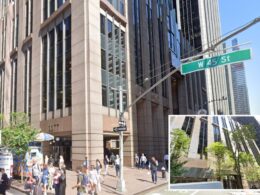Five years on, New York City office building foot traffic has all but recovered from the “work from home” losses caused by the pandemic — and here’s the proof.
Visits to office buildings in April were a mere 5.5% below April 2019 levels, authoritative Placer.ai platform found, making the Big Apple the nation’s clear leader in back-to-office trends.
Although office visits were also up in most other major US cities compared with the previous month, their average April attendance was 30.7% below 2019’s average, according to Placer.ai.
Los Angeles, Chicago and San Francisco brought up the rear, with April office visits 42% to 44% below 2019 levels.
Placer.ai analyzes cell phone data to determine foot traffic. It covers 1,000 buildings nationwide but doesn’t say how many are in each city.
The data confirm the larger trend that Realty Check has long observed. It’s great news for developers and landlords still beleaugered by reduced property values and high interest rates.
But while Manhattan office attendance is clearly surging, is it truly back to 94.5% of pre-pandemic averages, as Placer.ai says?
It sure looks that way on Park and Sixth avenues in Midtown, at Hudson Yards and Manhattan West, and at or near the World Trade Center. Office tower lobbies and sidewalks are busy as they haven’t been since before March 2019.
The large new leases and expansions we’ve reported since Jan. 1 — by Amazon, Aquarian Holdings, Amalgamated Bank and several law firms — testify to an appetite for space undeterred by “hybrid” trends.
JASON SZENES FOR THE NEW YORK POST
We’ve written repeatedly that large-scale office returns were taking place even before JPMorgan Chase, Apple, Alphabet and other major companies dragged employees kicking and whining to their desks this year.
Even so, let’s raise a few polite qualifiers about Placer.ai’s report.
Ongoing conversions of scores of obsolete office towers to apartments removed a significant number of sparsely-populated office buildings from the inventory over the past three years — and, presumably, from Placer.ai’s analysis.
And we wish Placer.ai would share at least some of the locations it monitors — a lack of transparency that also afflicts the notoriously opaque, widely discredited Kastle Back-to-Work Barometer.
But even after nitpickings, it’s obvious that Placer.ai is immeasurably more accurate than Kastle’s survey, which was mainly a marketing gimmick for the company’s security services. The “barometer” counts card-swipes only in mostly Class-B buildings where Kastle provides the services.
Executives of the largest real estate companies, such as publicly-traded SL Green and privately-held Related Companies — neither of whose buildings are monitored by Kastle — have told us since mid-2024 that WFH was in the rear-view mirror and no longer a factor in decision-making by landlords or tenants.
Even so, many media accounts continued to cite Kastle’s lowball claims of 55% office occupancy as recently as last summer — until the preponderance of evidence made it wiser to ignore.








